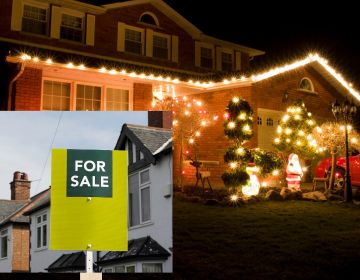- England has the highest proportion of inadequate housing in Europe, with 15 per cent of all existing homes not meeting the Decent Homes Standard and more substandard homes than Hungary, Poland and Lithuania; and
- The UK has some of the oldest housing stock in the developed world with only seven per cent of British homes built after 2001, far less than other countries like Spain, with 18.5, and Portugal with 16 per cent.
Boosting home ownership has been a key ambition for politicians, yet HBF’s research shows this is becoming increasingly unachievable for many as house prices continue to outstrip incomes.
Between 2004 and 2021 the UK’s rate of home ownership fell by six percentage points from 71 to 65 per cent. Over the same period, levels of home ownership grew by nearly 10 per cent in France and by 15 per cent in the Netherlands.
Despite manifesto commitments and repeated promises to boost numbers, the policy environment has slowed the delivery of new homes.
The UK remains a long way off delivering the Government’s target of 300,000 new homes per year by the mid-2020s, with only 233,000 new homes completed in 2021-22 and delivery in the first half of 2023 down by 10 per cent.
Analysis shows that record-breaking house building of 320,000 homes per year – nearly 100,000 more than current delivery – would be required for England to provide homes for its population in line with the benchmark for developed nations worldwide, the OECD.
Even just to reach the number of homes per thousand inhabitants of small European nations would require a significant increase in delivery. England would need to build 291,000 new homes every year until 2030 to reach the level of homes enjoyed by Belgium and 390,000 homes per year to be comparable to Denmark.
The average price of a property in England and Wales is more than eight times the average salary, making these - in the words of the HBF - “staggeringly unaffordable places to live.”
Even when looking at countries with similar reputations for unaffordable housing, the UK compares poorly, the analysis finds.
Denmark has one of the world’s most expensive and competitive property markets, with house prices rising faster than incomes in recent years, as shown by rapid growth of 12 per cent in the house price to income ratio between 2004 and 2021. However, this pales in comparison to England and Wales, where the ratio has grown by 37 per cent over the same period.
The UK has some of the oldest housing stock in the developed world. Even despite historically high levels of housebuilding over the past decade, only seven per cent of British homes were built after 2001, far less than other countries like Spain with 18.5 per cent, and Portugal with 16 per cent.
Even countries with smaller economies in Eastern Europe perform better than the UK. Hungary, for example, has one of the lowest average annual incomes in Europe and a GDP 17 times smaller than the UK, yet Hungarian houses are much more modern than British ones. Half of Hungarian homes were built after 1971, compared to only a third of the UK’s housing stock.
Homes in England are also of much poorer condition than in other developed countries, the analysis claims.
As of 2020, England had the highest proportion of inadequate housing in Europe, with 15 per cent of all homes not meeting the Decent Homes Standard, a measure set by the government which requires homes to be in a reasonable state of repair with reasonably modern facilities and services.
This means homes in England are in much worse condition than in Eastern European nations, including Lithuania, where 11 per cent of homes are substandard, and Poland, where only six per cent do not reach the required standard.
Want to comment on this story? Our focus is on providing a platform for you to share your insights and views and we welcome contributions.
If any post is considered to victimise, harass, degrade or intimidate an individual or group of individuals, then the post may be deleted and the individual immediately banned from posting in future.
Please help us by reporting comments you consider to be unduly offensive so we can review and take action if necessary. Thank you.
















.jpg)









%20(002).png)




.png)






Join the conversation
Jump to latest comment and add your reply
Social housing is not the private landlord's responsibility. Tories and the labour government need to spend more money planning a decent investment in line with its population growth and needs. Governments are more concerned with investments where they can make more money for themselves (such as financing "just wars", et cetera). Housing is a significant emergency here, much bigger than an environmental one, and those responsible for this crisis are politicians only.
I could find 6 million a day quite quickly.
It's pretty easy to fix:
1. Install two layers of Rockwool in the loft, one at right angles to the other and padlock the hatch shut
2. Fill the cavity with insulation (unless your house faces the ocean and has appalling brickwork pointing)
3. Install 5cm of Celotex on the inside of external walls and redecorate
4. Philips LED light bulbs in all fittings
5. Buy WindowSkin winter secondary glazing
6. Electrician to fit Dimplex Quantum electric heaters running on Octopus Energy's cheap midnight to 4 am tariff
7. Handyman to install Nuair Drimaster Heat PIV ventilation unit in the hallway with ON/OFF button in a lockable case from SSP Direct - totally eliminates condensation and mould and your washing & towels dry all year round
8. Get a draft predicted domestic EPC from a energy assessor, who is a professional member of PEPA, BEFORE the works and get them back AFTER the works to finalise the new, Lodged 10-year valid EPC.
Aim to get BOTH EPC Grades up to C, for the 'running cost' EPC Grade and the 'CO2 pollution' EPC Grade. Both Grades have been clearly shown on a domestic EPC for the past 15 years (despite what some folk write on this website!)
NOTE - I do not work for any of the above companies.
Its all common sense and will make our PRS and owner occupier housing stock - Fit for Purpose.
I await the responses as to why the above is totally impossible. They'll probably be the same reasons property owners used during the transition from outside privy to indoor bathroom, from fire risk to UK Fire Standards and from lethal asbestos to clean of asbestos.
Long term decisions for a brighter future.
Still not in the real world I see.
All fine when doing a complete refurb & you intend to keep the house for 20yrs, more of a problem with tenants in situ or a shorter time line. No mention of floor insulation Martin, you’re missing a trick.
Very informative Martin, I could agree with all that you have written for a change. Can you give an estimate to the cost though?
50mm of Celotex on internal walls will make some HMO rooms too small to let and some flats too small to be mortgageable.
SMH
Having Dimplex Quantum heaters isn't enough to qualify for the 4 hour Octopus Go tariff you mentioned. Someone would also need an EV or plug in hybrid car.
They could have Economy 7 but that's nowhere near as cheap as the EV tariff.
Gibbo, Seriously give it rest.... You have just spent 15k to save 120quid a year...!
You make less sense than the baghead that's bunkered down in my flat..
Lots of sense there Martin. But I would also add insulation to the first floor chamber to prevent cold bridging. And while we have also used Celotex internally there’s not a lot of scope on the front of terraced properties. Outriggers are the real cold spots.
How did Dimplex rig the EPC ratings for their HHR ( high heat retention) units?
Other makes are available but don’t seem to get the SAP points.
How does padlocking the loft hatch fit with the FRA? Serious question.
I find it annoying that new houses are considered better than old houses. As a HMO landlord I deal with a lot of old and new properties, and there is nothing better than a Victorian built house. In a modern new house you can punch through the walls, you would not be able to do that with a Victorian property. The Victorian properties can be adapted easily, are over built in that you could take half the structure away, and it still stands.
As for conservation or energy efficiency in old houses, I pay the bills in my HMOs and I can find there is little difference between the energy used in an old and new house, if anything, new houses cost more to heat. As I pointed out before, there’s something seriously wrong with our current energy conservation measures.
Look in London, the houses that were built in the 60s, to replace the old Victorian terraced houses that were demolished, yet the Victorian houses in other parts of London which are still standing are considered highly desirable.
Jim Haliburton, The HMODaddy
Completely agree with the sentiment here, though I prefer 30's and 50's houses myself, but take nothing away from Victorian and Edwardian houses that are beautifully built houses though , in my opinion, not as practical.
You're totally right. The gas bills in HMOs are fairly consistent regardless of age of property or EPC.
The following figures are taken from my September Octopus bills and are for annual estimated usage based on current gas prices and last year's usage. Quite why they don't use kWh is beyond me.
My 6 person HMO built in 1953 uses £1232 of gas for heating and hot water a year. It's EPC currently shows as E although it was previously a D.
A 5 person detached house built in 2004 (EPC C ) uses £1099 of gas.
A 4 person mid terrace built in 2004 (EPC C) uses £1071 of gas.
A 4 person semi built in 1982 (EPC C) uses £1030 of gas. That one is a student house, so only occupied 11 months a year.
On a per tenant basis that's between £205 in the 6 person EPC E house to £268 in the newest 4 bed per year.
My own house is EPC A and uses surplus solar energy to heat most of the hot water. Only 2 of us live in it and our gas usage is £866.52 a year. Our heating programmer is fine tuned to our specific life pattern whereas the HMO ones tend to be on for longer at slightly higher temperatures as I'm guessing about work and sleep patterns when I set them up. I use the theory it's better for them to be comfortable than to constantly be boosting the heating or trying to reprogram the heating controls.
On a per person basis our EPC A house costs more than double the per person amount in our EPC E HMO.
Or looked at another way it's £1 a day difference between my house and my 6 person HMO.
Agree totally Jim , property I have and around me was built 1860-1910 , still standing and as you said very desirable still, PCL
Oh and all C rated Mr Gibbons thx
Bang on the money Jimbo.
Martin Gibbons I do hope someone in Social Housing reads your excellent technical advice above and acts on it!
From my 30 years experience as a landlord, providing good quality accommodation for tenants, I have been made aware that sadly a lot of tenants do not know how to look after properties.
Ventilation, cleaning and heating adequately help to keep a property mould free and habitable.
Unfortunately neglect can sometimes be blamed on the landlord, when clearly it is the person living in the property who needs to care for it on a daily basis. Domestic tasks should be learned during childhood, if not at school! This sounds very old fashioned, but it’s true. Learning to take individual responsibility would solve a lot of “social problems” 🙂
Good post, I agree every word.
Pam do not come on here making sound common sense assessments of tenants, poor old Gibbo will be getting his Dimplex's all tied up....
Want to improve the quality of property in the rental section? Allow private landlords 100% of the cost spent on work carried out to bring the property up to standard, against all future tax bills until the money is 100% recovered by the Landlord. Alternatively make 100% grants available to Landlords for the improvements that are required to bring the properties up to a required standard, these grants would only become repayable when the property is sold through Capital gains tax allowances. Of course safeguards would have to be in place to prevent unscrupulous Landlords from profiteering.
HBF supporting newly built houses, I wonder why. I will stick with my mid 1800's house, it will survive a nuclear strike from Putin
I'll stick with my Victotian houses stood for over 100yrs and 2 world wars, will these new builds still be standing in 30 yrs time doubtful, timber frames, OSB board and plaster board, we see them being built by cow boy builders.
Andrew, foreign plywood and OSB is very poor. Further they are a very good fire risk.
They both rot and burn very well
The Climate is warming up and the World going on fire, when we were freezing in the early 1960’s we had no Insulation or Central Heating just Esso Blue or Pink. People are now too soft & over weight thanks to Digital Technology. The same Technology that has caused the Housing Crisis without which many of problems wouldn’t exist because they are artificially invented everyone addicted.
The Internal Celotex Insulation or similar is very good when you don’t have Cavity Walls. I have done this complete and skimmed, it makes other works easier like complete re-wire but as Tricia said it has to be a gut out.
Regarding the loft hatch don’t get me started on that. Harrow required me to replace with fire door & frame, a specification on how she wanted it involving cutting down a real fire door glued & lipped all around, I could have 2 Fire Doors done while messing around with that, easy to know none of those people can do anything in practice, there is nothing other than Insulation up there.
Polly beads are much better for Cavity Walls than Fibre, easier to install and fills every nook & cranny, don’t absorb or transmit moisture could be an answer to driving rain problem, fibre sometimes get stuck on wall ties or other obstacles ends up with cold spots and voids especially under windows as I am acutely aware having changed windows and nothing there.
I must get on with my day.
Previous generations building on brick and brick or block was a marvellous investment. Are you going to say all the wonderful properties in ltaly are crap. Will they pull the doges palace down, Oxford university Litchfield cathedral?? Carnarvon castle ? Houses in Islington were regarded as slums and lots of properties were demolished and replaced with new property that didn't last.
Please login to comment